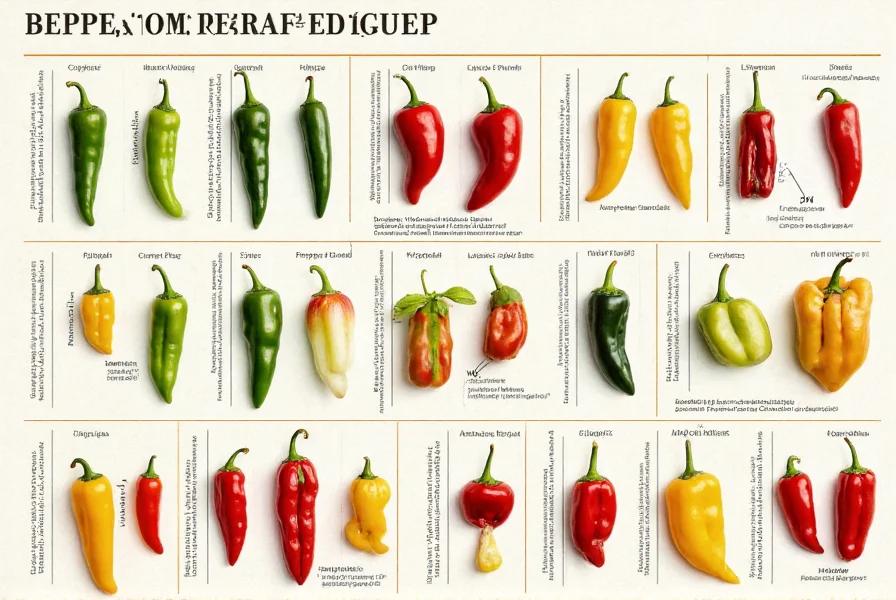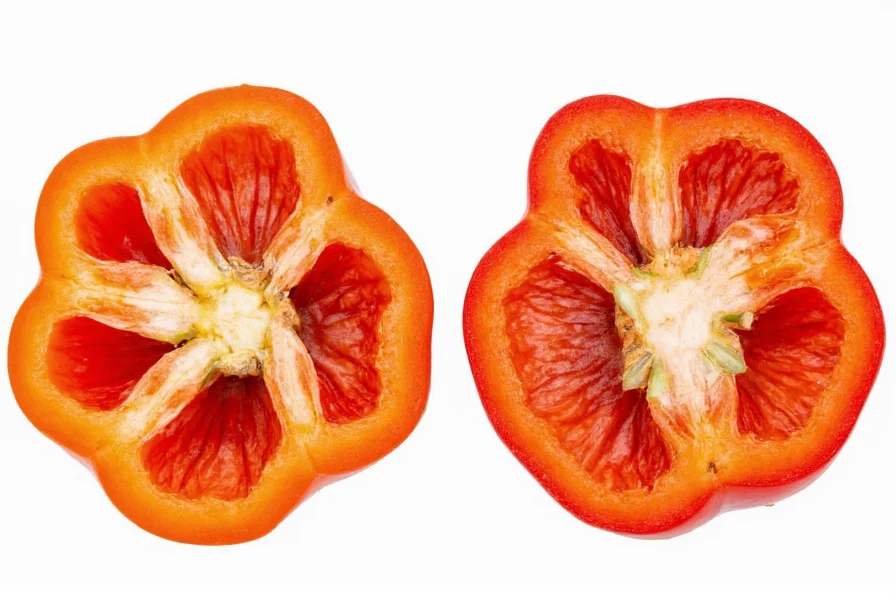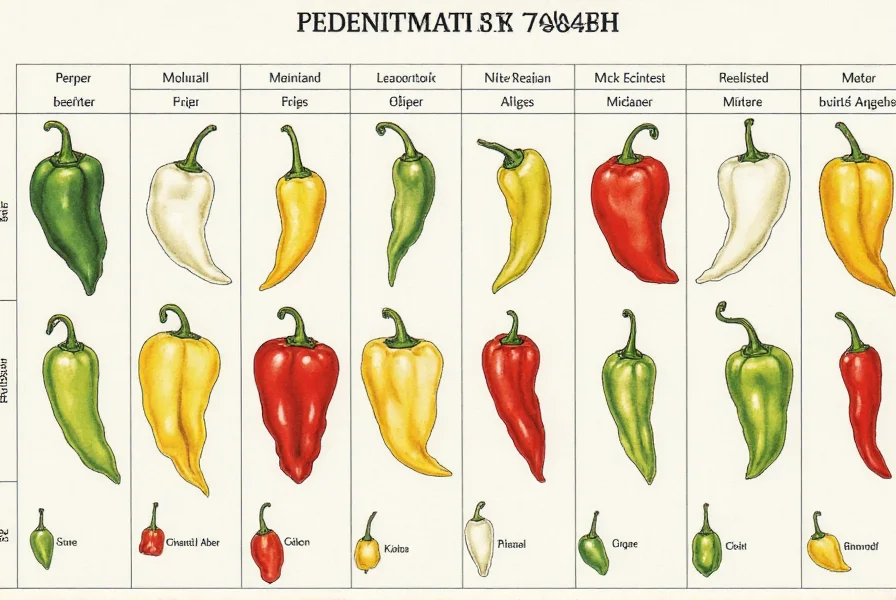Understanding pepper varieties is essential for both culinary success and gardening accuracy. Whether you're selecting ingredients for a recipe or identifying plants in your garden, recognizing the subtle differences between pepper types prevents culinary disasters and ensures proper plant care. This guide provides the most reliable visual and descriptive markers for accurate pepper identification.
Key Characteristics for Pepper Identification
Successful pepper identification requires examining multiple physical attributes simultaneously. Relying on just one characteristic often leads to misidentification, as many peppers share similar features at different growth stages. The following elements form the foundation of any effective pepper identification chart:
Heat Level (Scoville Scale)
The Scoville Heat Unit (SHU) measurement remains the most scientific method for distinguishing between chili pepper varieties. While bell peppers register 0 SHU, extremely hot varieties like Carolina Reapers exceed 1,500,000 SHU. Note that heat levels can vary based on growing conditions, but the relative heat ranking between varieties remains consistent.
Physical Appearance Markers
When identifying peppers visually, examine these critical features:
- Shape profile: Conical, blocky, elongated, or wrinkled
- Size dimensions: Length and width measurements at maturity
- Color progression: Many peppers change color as they ripen (green → yellow → orange → red)
- Surface texture: Smooth, glossy, wrinkled, or bumpy
- Stem characteristics: Shape and attachment point to the plant
Comprehensive Pepper Identification Chart
Use this detailed reference to identify common pepper varieties. Examine multiple characteristics simultaneously for accurate identification, as single features may overlap between varieties.
| Pepper Variety | Heat Level (SHU) | Typical Size | Color at Maturity | Distinctive Features |
|---|---|---|---|---|
| Bell Pepper | 0 | 3-4" x 2-3" | Green, red, yellow, orange | Blocky shape, 3-4 lobes at base, thick walls |
| Jalapeño | 2,500-8,000 | 2-3" x 1" | Green to red | Smooth skin, rounded shoulder, moderate taper |
| Serrano | 10,000-23,000 | 1-3" x 0.5" | Green to red | Vertical orientation on plant, thin walls, bright green |
| Habanero | 100,000-350,000 | 1-2.5" x 1-2" | Orange, red, white, chocolate | Lantern shape, deeply pitted skin, floral aroma |
| Thai Bird's Eye | 50,000-100,000 | 1-2" x 0.25" | Red, green | Small, upright growth, thin flesh, intense heat |
| Poblano | 1,000-2,000 | 4-6" x 2-3" | Dark green to red-brown | Heart-shaped, thick walls, mild earthy flavor |
| Cayenne | 30,000-50,000 | 6-8" x 0.5" | Bright red | Long, slender, tapered, smooth skin |
| Ghost Pepper (Bhut Jolokia) | 800,000-1,000,000 | 2.5" x 1" | Red, orange | Wrinkled skin, pointed tail, grows upright |
Practical Identification Techniques
When identifying peppers in real-world situations, follow these professional techniques:
Field Identification Process
- Observe growth habit: Note whether peppers grow pointing upward (common in extremely hot varieties) or downward (typical of milder peppers)
- Examine the calyx: The protective leaf structure around the stem attachment point varies by variety
- Check the interior: Cut open the pepper to examine seed color, placenta thickness (where seeds attach), and wall thickness
- Assess aroma: Many hot peppers have distinctive floral or fruity notes beyond just heat
Common Identification Mistakes to Avoid
Even experienced gardeners frequently confuse these similar varieties:
- Habanero vs. Scotch Bonnet: Both have similar heat levels, but Scotch Bonnets are more rounded with a distinctive "bonnet" shape
- Jalapeño vs. Serrano: Serranos are smaller, thinner, and significantly hotter than Jalapeños
- Red Bell vs. Pimento: Pimentos are heart-shaped with noticeably sweeter flavor and thinner walls
- Young Habanero vs. Ripe Serrano: At certain stages, these can appear similar but have vastly different heat profiles
Special Considerations for Pepper Identification
Color Variations Within Varieties
Many peppers change color dramatically as they ripen. For example, a green bell pepper is simply an unripe version of red, yellow, or orange bells. Similarly, jalapeños turn from green to bright red when fully mature. Always consider the ripeness stage when identifying peppers.
Regional Variations
Pepper characteristics can vary based on growing conditions. A habanero grown in tropical climates may be significantly larger and slightly milder than the same variety grown in temperate zones. When using a pepper identification chart, focus on relative proportions and distinctive features rather than absolute measurements.
Hybrid Varieties
Modern breeding has created numerous hybrid peppers that combine characteristics of multiple varieties. These may not fit perfectly into standard identification categories. When encountering unusual specimens, look for the most dominant characteristics to determine the closest match.

Using Pepper Identification in Practice
Accurate pepper identification serves several practical purposes:
- Culinary applications: Substituting the wrong pepper can ruin a dish. A cayenne cannot replace a poblano in stuffed pepper recipes due to dramatic heat differences
- Gardening management: Different pepper varieties have specific care requirements. Mistaking a ghost pepper for a bell pepper could lead to improper watering or fertilization
- Recipe adaptation: Understanding pepper characteristics allows for intelligent substitutions when specific varieties aren't available
- Safety considerations: Proper identification prevents accidental consumption of extremely hot peppers by those sensitive to capsaicin
When in doubt about a pepper's identity, perform a small taste test with extreme caution. Start with a tiny piece of the placenta (the white membrane where seeds attach), as this contains the highest concentration of capsaicin. Wait several minutes before consuming more to assess heat level safely.

Pepper Identification Resources
For ongoing reference, consider these reliable resources:
- University agricultural extension websites (most states have pepper variety guides)
- Seed company catalogs with detailed variety descriptions
- Specialized gardening apps with visual recognition features
- Local master gardener associations for regional expertise
Frequently Asked Questions
How can I tell if a pepper is hot without tasting it?
Examine the pepper's physical characteristics: hot peppers typically have thinner walls, grow pointing upward on the plant, and often have a shiny, smooth appearance. Check for small white striations (stretch marks) which indicate stress and higher capsaicin production. The shape also provides clues - conical or tapered peppers are usually hotter than blocky varieties. When in doubt, smell the stem end - hot peppers often have a distinctive sharp aroma.
Why do some red peppers look identical but have different heat levels?
Color alone cannot determine heat level as many pepper varieties reach red maturity at different heat intensities. A red bell pepper (0 SHU) and red cayenne (30,000-50,000 SHU) may appear similar but belong to completely different species. Always examine multiple characteristics including shape, size, wall thickness, and growth habit. The most reliable method is checking the Scoville rating for the specific variety, as color merely indicates ripeness stage rather than heat potential.
Can I use a regular ruler to measure peppers for identification?
Yes, a standard ruler provides sufficient accuracy for pepper identification. Measure length from stem to tip and width at the widest point. For small peppers like Thai bird's eyes, use millimeter measurements. Remember that size varies within varieties based on growing conditions, so focus on proportions (e.g., habaneros are typically as wide as they are long) rather than absolute measurements. Always measure multiple specimens from the same plant for the most accurate identification.
What's the most reliable single characteristic for pepper identification?
The growth habit (how peppers orient on the plant) is often the most reliable single identifier. Extremely hot peppers like ghost peppers and habaneros typically grow pointing upward, while milder varieties like bells and poblanos hang downward. This characteristic remains consistent across growing conditions and ripeness stages. Combine this with shape profile for the most accurate identification without tasting.











 浙公网安备
33010002000092号
浙公网安备
33010002000092号 浙B2-20120091-4
浙B2-20120091-4